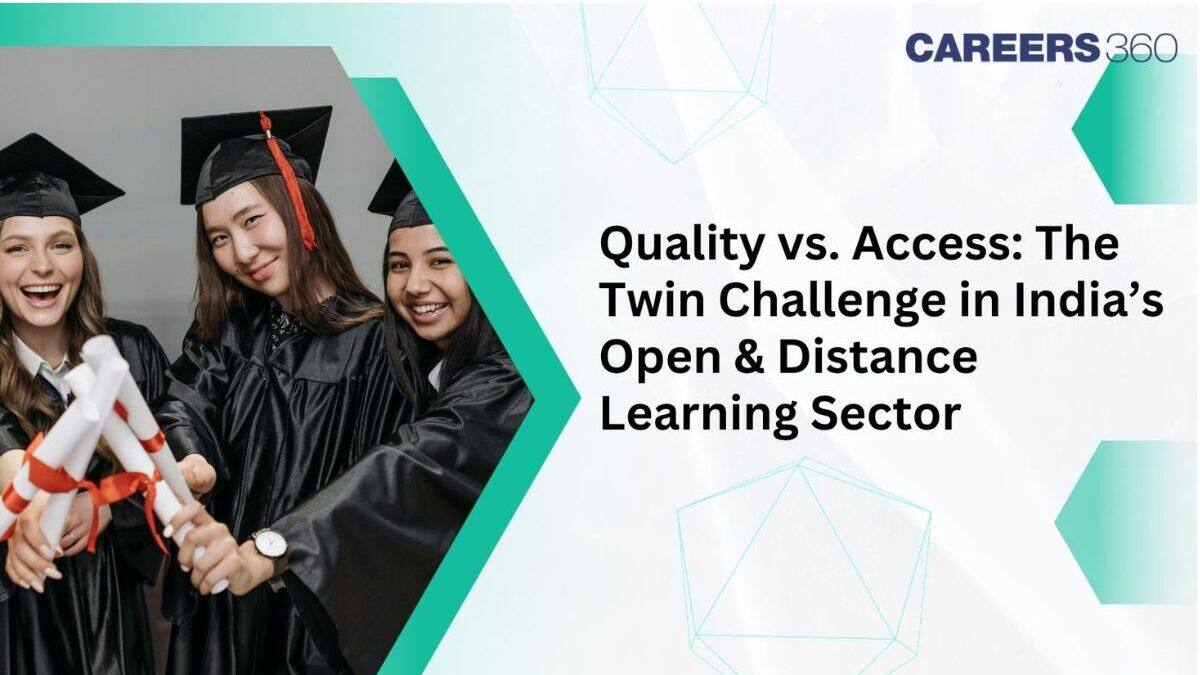Quality vs. Access: The Twin Challenge in India’s Open & Distance Learning Sector
India’s distance and online education system has come a long way from correspondence courses delivered by post to interactive virtual classrooms connecting millions nationwide. The transformation has revolutionsed access, enabling learners from diverse social and geographic backgrounds to pursue higher education in a virtual format.
This Story also Contains
- Expanding Educational Access: The Power of Openness
- The Persistent Quality Challenge
- Finding the Right Balance: Quality With Inclusion

Yet, this fast-growing field presents a crucial dilemma. While more students are gaining access to flexible learning opportunities, the question of maintaining consistent academic quality remains unresolved. Balancing inclusivity with educational excellence is now India’s most pressing challenge in the digital learning era.
Read the article to learn about how India’s open and distance education system balances accessibility with academic quality through digital innovation and technology-driven, inclusive education practices.
Expanding Educational Access: The Power of Openness
The growth of open and distance learning has reshaped India’s education landscape, making quality learning beyond urban classrooms. This openness has bridged social and geographic divides, giving learners from diverse backgrounds the freedom to study anytime, anywhere.
Breaking Barriers to Learning
Distance education has become a powerful tool for democratising education. Institutions such as the Indira Gandhi National Open University (IGNOU) and state open universities have long served rural, working, and differently-abled learners. Today, online platforms such as SWAYAM, NPTEL have brought global-quality education to every home. By removing geographic and financial barriers, open and distance learning empowers students to learn flexibly and achieve their goals.
Lifelong Learning for All
Online Learning enables students to learn at their own pace and convenience, whether they live in a metropolitan city such as Bengaluru or a remote district in Odisha. This accessibility has turned education into an ongoing process, not a one-time achievement, encouraging continuous skill development, career growth, and personal enrichment throughout life.
Also Read: UGC Recognised Universities For ODL Programmes 2025-26: Complete List, Approved Programmes
The Persistent Quality Challenge
Though online education is growing in India, it still faces concerns about academic quality and credibility. Ensuring consistent standards across institutions remains a major challenge, as colleges must balance flexibility with rigorous evaluation and meaningful student engagement. Quality accreditation and learner support is essential to build long-term trust among students.
Perception and Credibility Issues
Despite its benefits, distance education continues to face scepticism about its credibility. Employers often prefer traditional degrees, assuming that online programmes lack academic rigour. Outdated course materials, limited faculty interaction, and inconsistent evaluation systems still affect the quality of education at some institutions.
To ensure the higher standards, the UGC mandates that only universities with a NAAC score of 3.26 or higher or ranked in the top 100 of NIRF may offer online degree programmes. This move ensures that only credible institutions provide distance education, preventing unregulated expansion.
Digital Divide and Infrastructure Gaps
India’s digital learning ecosystem is not uniform. While premier institutions such as the IITs and Jamia Hamdard offer advanced online platforms, many regional universities lack strong Learning Management Systems (LMS) or stable internet connectivity. This imbalance limits equal participation, especially for rural learners, highlighting the urgent need for improved infrastructure and wider access.
Also Read: From Offline to Online: How Traditional Institutes Are Building Online Degree Programmes
Finding the Right Balance: Quality With Inclusion
Achieving harmony between quality and inclusion is essential for the long-term success of India’s distance education system. The focus now lies in integrating technology, innovation, and strong pedagogy to ensure that accessibility never comes at the cost of academic excellence.
Leveraging Technology and Pedagogical Innovation
Technology can play a major role in bridging the gap between quality and access. Tools such as AI tutors, adaptive assessments, and VR-based simulations can make online learning more interactive and result-oriented. However, technology alone is not enough, faculty training and pedagogical innovation are equally vital for sustaining quality.
A notable example is IIT Madras’s BSc in Data Science, which combines live lectures, discussion forums, and project-based evaluations. This model demonstrates how accessibility and academic excellence can coexist successfully in a digital framework.
Enhancing Student Support and Accountability
Strong regulatory oversight must be paired with student-centric practices. Regular feedback surveys, mentoring systems, and transparent evaluation processes can ensure accountability and continuous improvement. Building online peer communities can further promote collaboration and engagement qualities often missing in traditional distance education models.
India’s journey from correspondence courses to digitally connected classrooms symbolises its commitment to educational inclusivity. However, accessibility without assured quality can weaken the very foundation of learning.
The future of distance education depends on achieving equilibrium—where inclusivity, flexibility, and affordability merge seamlessly with credibility, innovation, and academic depth. With balanced regulation, technological advancement, and continuous faculty development, India can transform open learning into a powerful and globally respected model of higher education.
Frequently Asked Questions (FAQs)
Common programmes include BA, B.Com, BBA, MA, MBA, MCA, and M.Sc, designed for flexible, skill-oriented, and career-focused learning.
UGC recognises online and ODL degrees offered by universities meeting NAAC and NIRF criteria, ensuring credibility and nationwide acceptance.
Regular feedback, transparent evaluations, and student mentoring systems help maintain quality, accountability, and learner satisfaction in online programmes.
Adaptive learning systems, practical learning opportunities, and virtual labs make online education interactive, personalised, and aligned with real-world applications.
The biggest challenge in distance learning is maintaining consistent academic quality while ensuring active student engagement. Limited interaction, technological barriers, and self-discipline issues often affect learners’ overall performance.